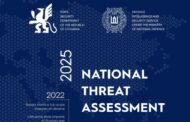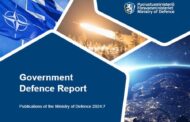A return to disarmament
Our goal of a world without nuclear weapons is receding ever further into the distance – but arms control must be brought back to centre stage. An article by Heiko Maas for the RND media Group.
_____________________________________________________________________________________________________________________________________
“Ballistic missile threat inbound to Hawaii. Seek immediate shelter.” That text message went out to hundreds of thousands of Hawaii residents on the morning of 13 January 2018. People panicked; they said goodbye to their loved ones. After 38 long minutes of uncertainty, the all-clear came: it had been a false alarm triggered by an employee of the Hawaii Emergency Management Agency.
The supposed missile attack was reported all over the world – in part, one presumes, because most of us find it unthinkable that such a thing could happen these days. Yet the nuclear-weapon states still possess almost 14,000 nuclear warheads. A single one would suffice to annihilate entire cities. And although the number of nuclear weapons has gone down slightly in recent years, investment in new systems is on the rise.
We are increasingly losing sight of our goal to free the world of nuclear weapons. And when we wake up on Friday, one of the most successful disarmament treaties of all time will have been consigned to history. It was in 1987 that Mikhail Gorbachev and Ronald Reagan agreed to completely eradicate land-based intermediate-range and cruise missiles. Right in the middle of the Cold War, a deadly risk for Europe was eliminated.
Ignoring all appeals and offers of dialogue, Russia has refused to destroy its non-compliant system and has even stationed state-of-the-art nuclear weapons in our neighbourhood. This is a source of great concern for us Europeans. We and our allies have been searching for the right – balanced, coordinated, defensive – responses. One thing is clear, after all: arms races do not make the world a safer place. On the contrary, if we fail to halt the collapse of the global architecture of arms control, there will be serious consequences for our security and for peace around the world.
We need a clear roadmap back to nuclear disarmament and arms control. And its scope needs to take in more than just Europe. China and others have more and more responsibility.
1. The first element must therefore be to place disarmament and arms control back on the international agenda and to get partners on board. That is why we saw to it that the United Nations Security Council would discuss nuclear disarmament and non-proliferation last April – for the first time since 2012! The discussion was encouragingly objective. Alongside Sweden, Japan and others, we have launched an initiative to revalidate the commitment to nuclear disarmament that the Non-Proliferation Treaty enshrined. To that end, I will be inviting my counterparts to Berlin in the coming months in view of the crucial NPT review conference next year.
2. We must prevent escalation. We will therefore push for more transparency on the arsenals of the nuclear-weapon states, promote restrictive deployment doctrines and develop robust verification procedures for the destruction of nuclear weapons. Together with our partners, we will do everything we can to prevent the further proliferation of nuclear weapons – North Korea being a case in point. All of this will require Germany’s full and active commitment.
3. Another element is the New START Treaty between the United States and Russia, which expires in 2021. It limits the strategic arsenals of the most powerful nuclear-weapon states and serves to prevent a nuclear arms race. We call on Washington and Moscow to commit now to extending the treaty when the time comes. This would allow time to adapt it to new developments – and it would send an urgently needed message of certainty in these uncertain times.
4. We need a structured dialogue on security in Europe, involving not only the US and Russia but the countries of Europe too. Only by communicating openly with one another – without blinkers but on the basis of clear principles – will we make progress. Ultimately, nothing that one side perceives as a threat can add to the other side’s security in the long term.
5. New technologies are creating entirely new challenges for the arms control of tomorrow. Fully autonomous weapon systems, hypersonic weapons, cyber threats, the military use of outer space – they all threaten to undermine the old rules and regulations. At our initiative, hundreds of diplomats and experts from all over the world gathered in Berlin in March to discuss the arms control of the future. That was a first. We intend to continue on that road, with, for example, a global dialogue on missile technology. The EU, too, needs to focus more on these issues, which will be one of the objectives of our Council Presidency in the coming year.
None of these steps will be easy. But every one of them will take us closer to our goal: a world without nuclear weapons; a more peaceful world. Germany wants to pursue that road with its partners – so that we don’t one day hear, “Ballistic missile threat inbound,” and it’s really not a drill.
* * * * *
Zdroj: https://www.auswaertiges-amt.de/en/newsroom/news/maas-inf-end/2236948







